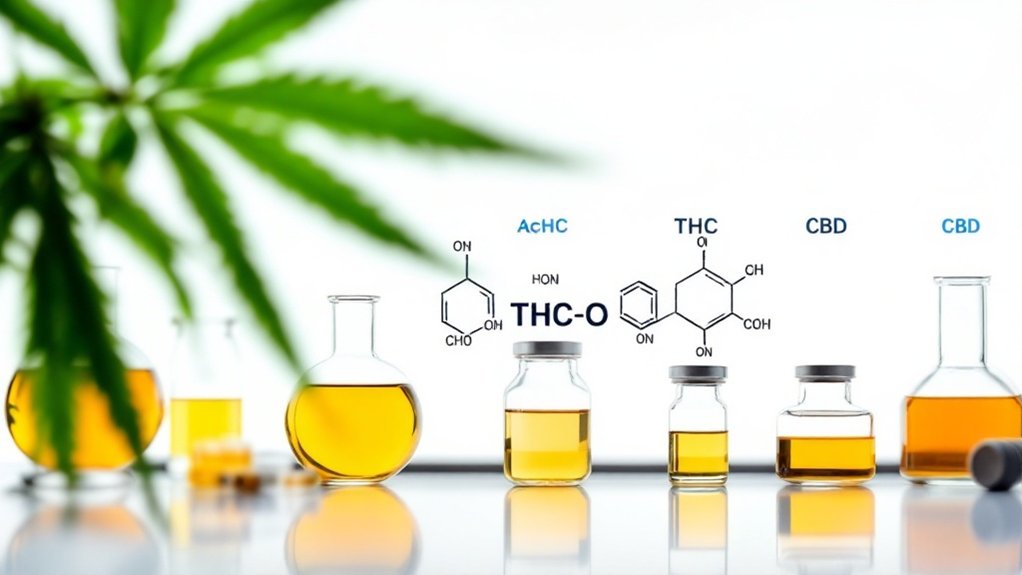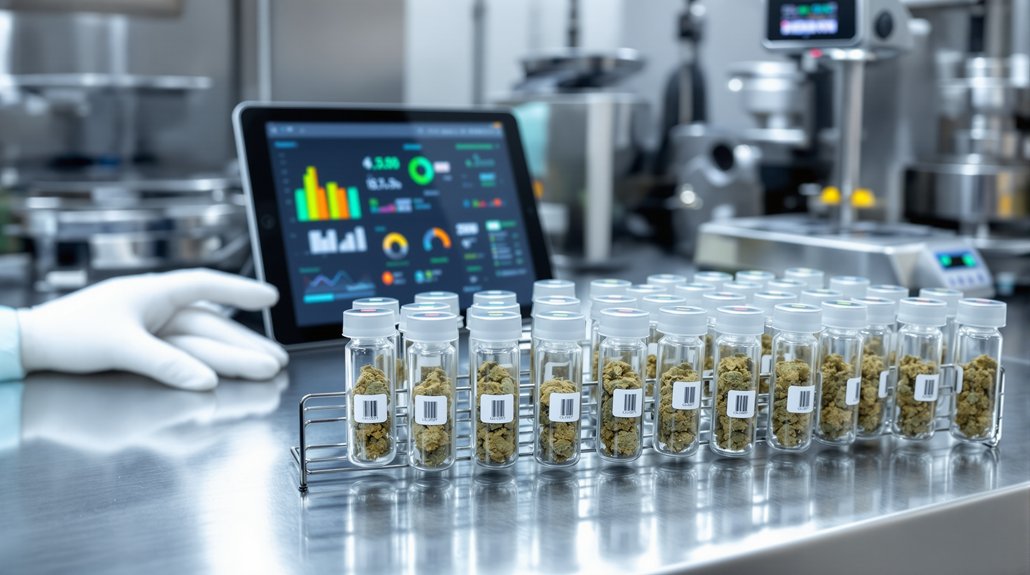THC-O is a synthetic cannabinoid created through acetylation of THC, replacing a hydrogen atom with an acetyl group. Unlike naturally occurring THC and CBD, THC-O functions as a prodrug, requiring metabolism before becoming active in the body. It possesses approximately four times the potency of traditional Delta-9 THC, necessitating careful dosing. THC-O cannot be naturally extracted like other cannabinoids and requires specific laboratory synthesis with reagents such as acetic anhydride. The compound’s unique chemical structure contributes to its distinctive effects.

The intricate world of cannabinoid chemistry has expanded considerably with the emergence of synthetic compounds like THC-O-acetate. This chemical, also known as THC acetate ester, O-acetyl-THC, or AcO-THC, represents a considerable molecular modification of the familiar THC molecule. With a molecular formula of C23H32O3 and molar mass of 356.506 g/mol, THC-O is created through an acetylation process where a hydrogen atom in the original THC structure is replaced by an acetyl group.
THC-O-acetate represents an advanced molecular evolution in cannabinoid science through precise acetylation of the classic THC structure.
Unlike naturally occurring cannabinoids found in cannabis plants, THC-O requires specific laboratory processing for its creation. Commercial synthesis typically employs reagents such as acetic anhydride, acetyl chloride, or ketene to facilitate the acetylation process. This transformation can be performed on either Δ9-THC or Δ8-THC, producing corresponding variants known as Δ9-THC-O or Δ8-THC-O respectively, with the primary difference being the location of a double bond within the cyclohexene ring system. Research has shown that vaping THC-O products can lead to the formation of potentially hazardous ketene gas during heating.
THC-O functions differently from natural cannabinoids in how it affects the human body. It is considered a prodrug, which means it becomes pharmacologically active only after metabolism occurs within the body. This characteristic distinguishes it from both Delta-9 THC and CBD, which interact with the endocannabinoid system directly upon consumption. The acetylation process potentially increases potency compared to the parent compound, though pharmacological differences between various THC-O variants remain understudied. Studies indicate that THC-O is approximately four times stronger than traditional Delta-9 THC, requiring careful dosage consideration for consumers.
Several related compounds exist within this chemical family, including THC-O-propionate, THC-O-phosphate, and THC hemisuccinate. Additionally, the hydrogenated derivative HHC-O-acetate represents another branch of this synthetic cannabinoid tree. Unlike HHC (hexahydrocannabinol), which is created through hydrogenation by adding hydrogen molecules to Delta-9 THC, THC-O undergoes the distinct chemical process of acetylation.
The legal status of THC-O varies greatly across jurisdictions and continues to evolve as regulatory frameworks address synthetic cannabinoids. Classification often differs from naturally occurring compounds like Delta-9 THC or CBD. This synthetic nature means that THC-O cannot be obtained through conventional hemp extraction methods, requiring instead controlled laboratory conditions and specific chemical reagents for production.
As research continues, understanding of THC-O’s pharmacological properties and potential differences from natural cannabinoids will likely expand.
Frequently Asked Questions
Is THC-O Legal in All States?
THC-O is not legal in all states despite federal rulings that hemp-derived THC-O with less than 0.3% Delta-9 THC is federally legal.
State regulations vary greatly, with some states explicitly prohibiting THC-O while others permit it under specific restrictions.
The Fourth Circuit Court of Appeals ruled against the DEA’s classification of THC-O as a Schedule I substance in February 2025, but this federal decision does not override state-level prohibitions.
How Long Do THC-O Effects Typically Last?
THC-O effects typically last between 4-8 hours, varying based on several factors.
When inhaled through vaping, the experience generally lasts 2-4 hours, while edible forms produce longer durations of 4-6 hours, occasionally extending up to 8 hours.
Individual metabolism, body weight, and consumption method greatly influence these timeframes.
Some residual effects may persist for up to 12 hours after consumption, with edible forms potentially affecting users into the following day.
Will THC-O Show up on a Drug Test?
Yes, THC-O will show up on standard drug tests.
It metabolizes into 11-hydroxy-THC, the same metabolite produced by traditional THC products that drug tests screen for.
Detection windows vary by test type: 3-30 days in urine, up to 36 hours in blood, 48-72 hours in saliva, and up to 90 days in hair follicle tests.
Current testing methods cannot distinguish between THC-O and other THC analogs, regardless of their legal status.
What Is the Appropriate THC-O Dosage for Beginners?
Beginners should approach THC-O cautiously, starting with just 1-3 milligrams per dose.
This cannabinoid produces stronger psychedelic effects than traditional THC, making conservative initial dosing essential. Absolute novices should limit their first experience to a maximum of 2mg, allowing their body to acclimate to its potent effects.
Users should follow the “start low, go slow” principle, gradually increasing dosage over multiple sessions until finding their ideal threshold within the low tolerance range of 3-10mg.
Are There Any Potential Side Effects of THC-O?
THC-O can produce several concerning side effects with varying severity. Users frequently report respiratory issues including coughing and lung irritation, particularly when vaping.
Psychological effects include anxiety, paranoia, and in some cases, hallucinatory experiences or psychosis-like symptoms at higher doses.
Physical discomfort such as nausea, mouth dryness, and increased urination are common.
Most alarmingly, THC-O produces ketene when heated, a toxic compound associated with EVALI, raising significant long-term health concerns due to limited research on this synthetic cannabinoid.









